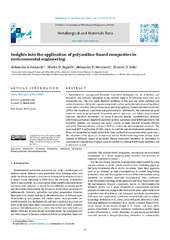Приказ основних података о документу
Insights into the application of polyaniline-based composites in environmental engineering
| dc.contributor | Raić, Karlo | |
| dc.creator | Jovanović, Aleksandar | |
| dc.creator | Bugarčić, Mladen | |
| dc.creator | Marinković, Aleksandar | |
| dc.creator | Sokić, Miroslav | |
| dc.date.accessioned | 2023-06-30T10:45:28Z | |
| dc.date.available | 2023-06-30T10:45:28Z | |
| dc.date.issued | 2023 | |
| dc.identifier.issn | 2956-1787 | |
| dc.identifier.issn | 2956-1795 (Online) | |
| dc.identifier.uri | https://www.metall-mater-data.com/index.php/home/article/view/1 | |
| dc.identifier.uri | https://ritnms.itnms.ac.rs/handle/123456789/658 | |
| dc.description.abstract | Environmental management demands innovative techniques for its protection and treatment. The essential agreement of the modern world is to overcome every issue in a sustainable way. The two major financial problems in this area are water pollution and material corrosion. Persistent, organic compounds such as pesticides have devastating effects on the water ecosystem. This problem can be solved by applying advanced treatment processes (ATPs) like membrane separation and photocatalysis. Additionally, the corrosion of metal materials needs to be prevented to preserve natural resources and reduce environmental concerns. Therefore, researchers are trying to develop tunable, multifunctional materials with broad applications. Employed materials in these operations must fulfill high criteria, like durability, stability, and chemical and optical activity, to make specified processes efficient and viable. Electroconductive polymers (ECPs) can meet the aforementioned standards. The most used ECP is polyaniline (PANI), due to its catalytic and electrochemical performances. These two properties are beneficial for both water purification and anticorrosion applications. The objectives of the paper are to represent various PANI-based composites utilized in the removal of different classes of pesticides during wastewater treatment by adsorption or photocatalytic degradation. Further corrosion inhibition, utilizing PANI-based inhibitors, will be discussed as well. | sr |
| dc.language.iso | en | sr |
| dc.publisher | Belgrade : Association of Metallurgical Engineers of Serbia | sr |
| dc.relation | info:eu-repo/grantAgreement/MESTD/inst-2020/200023/RS// | sr |
| dc.relation | info:eu-repo/grantAgreement/MESTD/inst-2020/200135/RS// | sr |
| dc.rights | openAccess | sr |
| dc.rights.uri | https://creativecommons.org/licenses/by/4.0/ | |
| dc.source | Metallurgical and Materials Data | sr |
| dc.subject | wastewater treatment | sr |
| dc.subject | membrane adsorption | sr |
| dc.subject | polyaniline | sr |
| dc.subject | photodegradation | sr |
| dc.subject | corrosion protection | sr |
| dc.title | Insights into the application of polyaniline-based composites in environmental engineering | sr |
| dc.type | article | sr |
| dc.rights.license | BY | sr |
| dc.citation.epage | 31 | |
| dc.citation.issue | 1 | |
| dc.citation.spage | 25 | |
| dc.citation.volume | 1 | |
| dc.identifier.doi | doi.org/10.56801/MMD1 | |
| dc.identifier.fulltext | http://ritnms.itnms.ac.rs/bitstream/id/1143/5_MMD_1.pdf | |
| dc.type.version | publishedVersion | sr |

